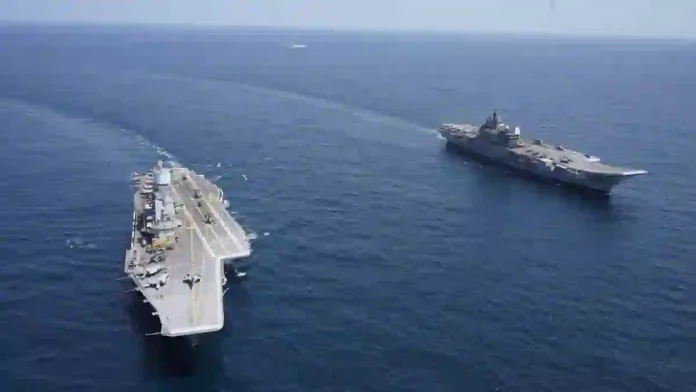The Indian Navy has officially decided that the planned second indigenous aircraft carrier (IAC-2) will replace the existing INS Vikramaditya rather than serve as a third carrier. This marks a significant shift in naval strategy, moving away from earlier discussions about expanding the fleet to three operational carriers, which would have allowed for simultaneous operation of two carriers while one was under maintenance.
Current Carrier Status
As of now, the Indian Navy operates two aircraft carriers:
INS Vikramaditya: A refurbished Russian carrier, weighing approximately 45,000 tons.
INS Vikrant: India’s first domestically built carrier, commissioned in September 2022, also displacing around 45,000 tons.
Future Plans For IAC-2
The IAC-2 is expected to be a larger vessel, with plans indicating a displacement of around 65,000 tonnes. It will incorporate advanced features such as a Catapult Assisted Take Off But Arrested Recovery (CATOBAR) system and electric propulsion. However, the project is still awaiting formal government approval despite having received “in-principle” approval from the Defence Procurement Board in late 2023.
Strategic Shift Towards Submarines
The Indian government has emphasized a strategic pivot towards enhancing submarine capabilities over expanding aircraft carrier numbers. This decision aligns with views expressed by former military leaders who argued against the necessity of three carriers, labelling them as potentially vulnerable targets in modern naval warfare. The Navy is now focusing on acquiring submarines and other advanced technologies to bolster its maritime strength.
Impact Analysis
The introduction of the Indigenous Aircraft Carrier-2 (IAC-2) is set to significantly enhance the Indian Navy’s strategic capabilities, impacting various dimensions of maritime security and operational effectiveness.
Enhanced Strategic Deterrence
IAC-2 will serve as a critical element in India’s deterrence strategy against potential adversaries, particularly in the context of rising naval capabilities from nations like China. Its presence will reinforce India’s commitment to safeguarding its maritime interests and contribute to regional stability by acting as a formidable deterrent against aggressive actions in the Indo-Pacific region.
Operational Versatility
The carrier will enhance operational flexibility, enabling the Indian Navy to conduct a diverse range of missions, including power projection, maritime security operations, and humanitarian assistance. This versatility is crucial for addressing evolving maritime challenges and ensuring that India can respond effectively to various security threats.
Read- INS Aridhaman Set To Be Commissioned And Inducted This Year
Step Forward
The construction and operation of IAC-2 are expected to drive significant technological advancements within India’s indigenous defence sector. This initiative will stimulate research and development, promoting self-reliance and technological sovereignty in naval capabilities. Advanced features such as the Electromagnetic Aircraft Launch System (EMALS) may be incorporated, enhancing the carrier’s operational capabilities.
Budgetary Considerations And Strategic Alignment
While IAC-2 represents a leap forward in naval capabilities, it also raises concerns regarding budgetary constraints and resource allocation amidst competing defence priorities. The high costs associated with constructing and operating aircraft carriers necessitate careful consideration of how best to balance investments across different military domains, including submarines and surface combatants.
Conclusion
The Indian Navy’s approach reflects a broader strategic consideration of balancing air and sea power while addressing contemporary threats in the region. The transition to IAC-2 as a replacement for INS Vikramaditya underscores an evolving naval doctrine aimed at maintaining operational readiness and effectiveness without overextending resources on multiple carriers.
IDN
Agencies




